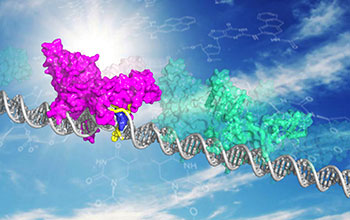Multimedia Gallery
XPC DNA repair protein shown in two modes
This graphic shows the DNA repair protein xeroderma pigmentosum C, or XPC, in two modes: patrolling undamaged DNA (in green) and bound to a DNA damage site (magenta, with blue XPC insert opening the site). The sun behind the molecule is a reminder that the sun is the primary source of lesions recognized by XPC.
More about this image
Sites where DNA is damaged may cause a molecule that slides along the DNA strand to scan for damage to slow on its patrol, delaying it long enough to recognize and initiate repair. This finding by researchers at the University of Illinois at Chicago suggests that the delay itself may be the key that allows the protein molecule to find its target.
XPC is important for the repair of DNA damaged by environmental stresses like the chemicals in cigarette smoke and pollutants, which makes it important for preventing cancers the researchers say. Dysfunctional XPC may lead to a 1,000-fold increase in the risk of skin cancer.
The research was supported in part by National Science Foundation (NSF) grants MCB 07-21937, MCB 11-58217 and MCB 14-12692.
To learn more, see the NSF News From the Field story Damaged DNA may stall patrolling molecule to initiate repair. (Date image taken: January 2015; date originally posted to NSF Multimedia Gallery: Nov. 25, 2015)
Credit: Jung-Hyun Min and Myrna Romero, University of Illinois at Chicago
See other images like this on your iPhone or iPad download NSF Science Zone on the Apple App Store.
Images and other media in the National Science Foundation Multimedia Gallery are available for use in print and electronic material by NSF employees, members of the media, university staff, teachers and the general public. All media in the gallery are intended for personal, educational and nonprofit/non-commercial use only.
Images credited to the National Science Foundation, a federal agency, are in the public domain. The images were created by employees of the United States Government as part of their official duties or prepared by contractors as "works for hire" for NSF. You may freely use NSF-credited images and, at your discretion, credit NSF with a "Courtesy: National Science Foundation" notation.
Additional information about general usage can be found in Conditions.
Also Available:
Download the high-resolution JPG version of the image. (985 KB)
Use your mouse to right-click (Mac users may need to Ctrl-click) the link above and choose the option that will save the file or target to your computer.



